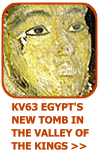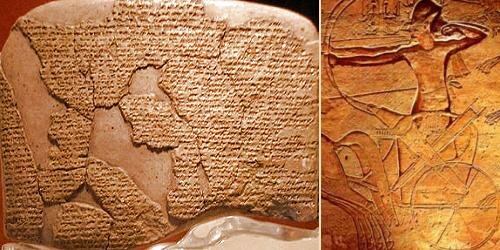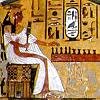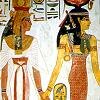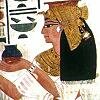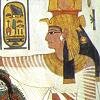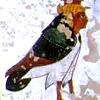|
|
|||||||||||||||||||||||||
|
|
Pharaoh profiles: Akhenaten | Alexander the Great | Cleopatra VII | Hatshepsut | Ramesses the Great | Tutankhamun | Tuthmosis III Ramesses II (throne name User-maat-re Setep-en-re). Ramesses II (ruled c.1279-1213 BC) was the third ruler of the 19th Dynasty, the son of the successful Seti I (himself the son of Ramesses I). An enormous number of temples, monuments and statues were created (and usurped) from earlier rulers during his long and illustrious reign, including the famous rock-cut temple of Abu Simbel in Nubia, numerous temples at Memphis, the decoration of the great Hypostyle Hall at Karnak, and his mortuary temple, the Ramesseum at Thebes. The great dedication stele in the temple at Abydos is the longest inscription of Ramesses II's reign (116 lines) and is the main source for details of his earlier years and of his relationship with his father in the kingship. Ramesses the Builder This extraordinarily long reign, the wealth available in the state coffers, and, undeniably, the pharaoh's personal vanity meant that Ramesses, of all the ancient rulers, left what is perhaps the most indelible mark on the country. His legacy can be seen most clearly in the archaeological record – in the many buildings that Ramesses modified, usurped, or constructed from the ground up. His building achievements stand pre-eminent amongst the pharaohs of Egypt. He added to the great temples at Karnak and Luxor, completed his father's (Seti I) mortuary temple at Gourna (Thebes) and also his temple at Abydos, and then built his own temple at Abydos.
On the west bank at Thebes he constructed a giant mortuary temple known as the Ramesseum. In Nubia he built mortuary temples at Beit el-Wali, Gerf Hussein, Wadi es-Suba, Derr and Napata. The greatest achievement without a doubt however, has to have been the two temples at Abu Simbel in Nubia. The Great temple was a miracle of engineering and its orientation was so precise that the rising sun on the spring and vernal equinox would flood directly through the great entrance to illuminate the gods of the Sanctuary, over 200 ft/60m inside the mountain.
Battle of Kadesh One of the major events of his reign was the confrontation with the Hittites at the Battle of Kadesh. Celebrated repeatedly on the walls of his major temples, this propaganda ensured that the Hittite empire was kept at bay and Egyptian interests in the Levant were protected. He eventually signed a treaty with the Hittites in 1258 BC, the 21st year of Ramesses II's reign, with the new king of the Hittites, Hattusili III. A large number of the letters sent by Ramesses II to the Hittite King and his wife are now contained within the archive of cuneiform tablets at Boghazköy. This battle marked a stalemate between Hittite and Egyptian power and the two met face to face along their outermost marches, in what is now Syria. The Hittites, based at Carchemish, were angry over the defection of Amurru* (to Egypt and wanted to bring it back under control – on the other hand the Egyptians wanted to protect their new vassal. The Hittite king Muwatallis, who had mustered several of his allies (among them Rimisharrinaa, the king of Aleppo), had positioned his troops behind the hill at Kadesh, but Ramesses thought they were at Aleppo and learned the truth only after capturing two Hittites. Immediately Ramesses sent messengers to hasten the coming of the Ptah and Setekh divisions of his army which were still on the far side of the river Orontes.
Before Ramesses could gather them all together, however, 2500 of Muwatillis' chariots attacked the Re and Amun divisions and plundered the Egyptian camp. The Egyptians retreated, and Ramesses himself narrowly escaped capture, mainly thanks to the intervention of a troop contingent from Amurru, which suddenly arrived to assist the pharaoh and drive the Hittites back. The Egyptians regrouped and almost surrounded the Hittites, but the Hittite chariots retreated back across the Orontes to join their infantry. Muwatallis called for a truce with Ramesses. Though both sides later proclaimed the battle a victory, Ramesses' troops had suffered many casualties and he was unable to capture any more territory. The Hittite king, on the other hand, continued to campaign successfully as far south as Apa. Kadesh remained in Hittite hands, and Amurru was recaptured by the Hittites. The consequent loss of prestige sparked revolts within the Egyptian empire, and Ramesses could not resume direct hostilities against the Hittites until 1269 BC. *The deity of the Amorite people - semitic people who occupied the country west of the Euphrates from the second half of the third millennium BC. Ramesses established a new capital called Pi-Ramesse at a site near modern el-Khatana, where his father Seti I had previously build a palace. This became the capital city for the duration of his reign, although the Royal Cemetery remained as the Valley of the Kings at Thebes. Ramesses mummy was one of those found in the Royal Cache at Deir el-Bahri, which was discovered by local "dragoman" (tourist guide) Ahmed Abd er-Rassul in 1871. Eight royal Queens During his long reign, Ramesses had eight principle wives, but Nefetari was his first and favourite of them all. Her tomb is one of the finest in the Valley of the Kings.
A Fine Old Age
When he eventually died Ramesses was succeeded by his 13th son Merenptah. Merenptah was middle aged by the time he eventually came to power, the first of several short lived rulers who had perhaps already passed their peak as a result of Ramesses' unusually long reign. IMPORTANT NOTE: The precise dates of the Egyptian Dynasties and of individual reigns are still the subject of much scholarly debate. Students and other individuals who use this website should therefore be aware that the dates shown for the dynasties and individual reigns throughout this site may sometimes differ to the dates that are used in other publications.
|
||||||||||||||||||||||||

|
|||||||||||||||||||||||||
|
|||||||||||||||||||||||||





